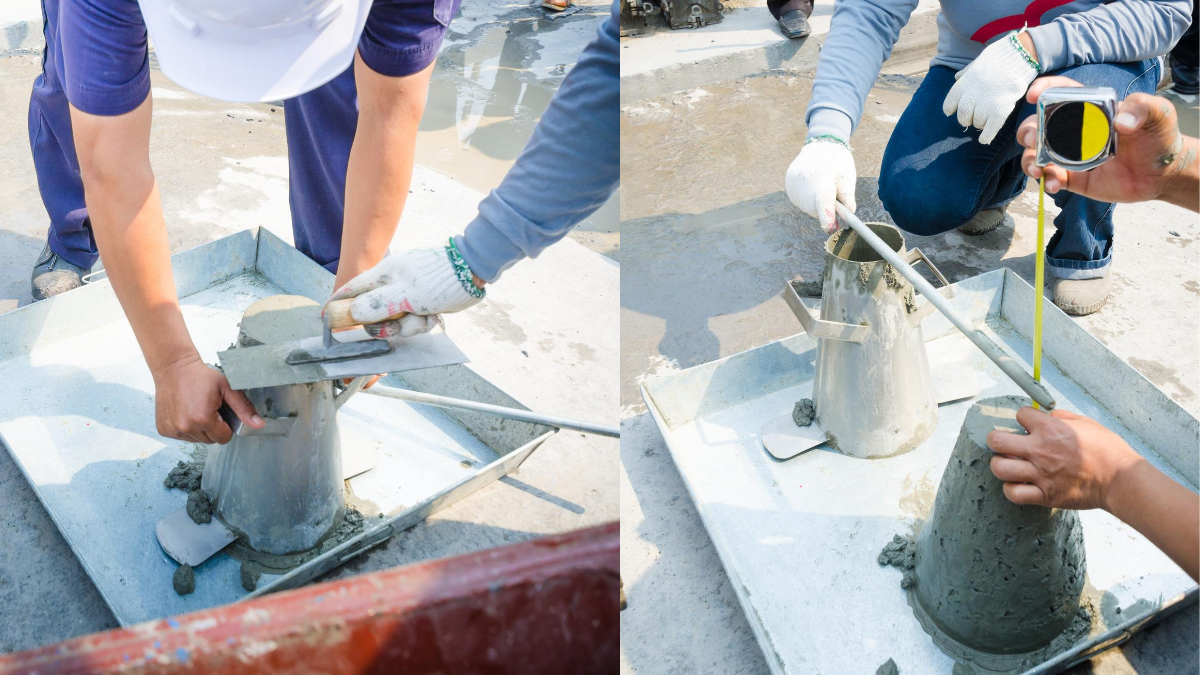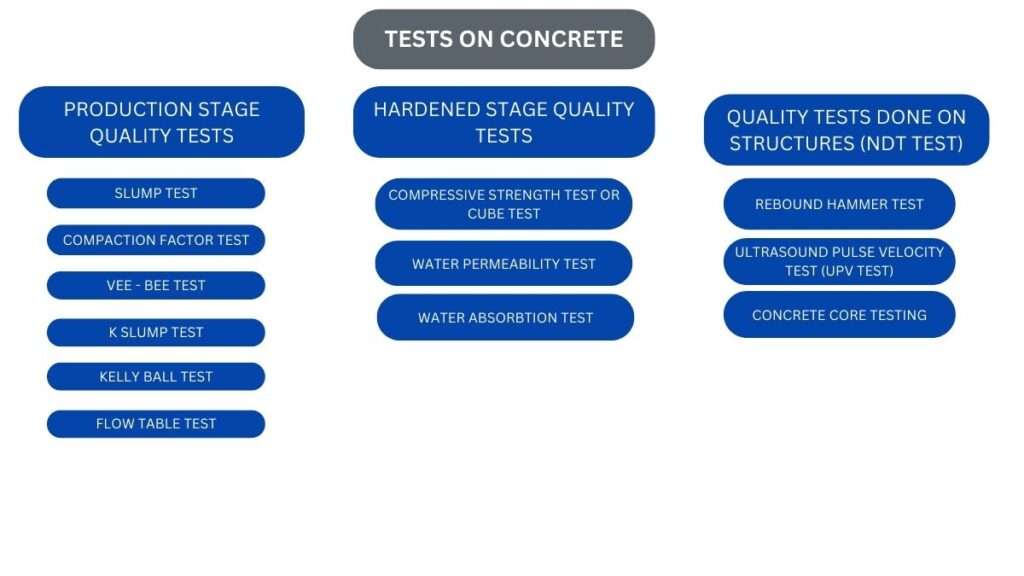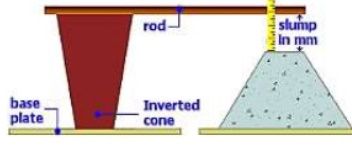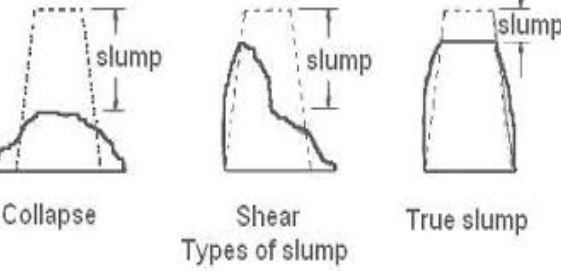Slump test of Concrete, also known as a slump cone test, is performed to determine the workability or consistency of a concrete mix prepared in the laboratory or on the job site as the work progresses. Mostly, a slump test is performed from batch to batch to ensure that the consistency of the concrete is consistent during the construction process.
Generally, the concrete slump value is used to determine workability, which implies the water-cement ratio, but the concrete slump value is affected by a variety of factors such as material properties, mixing processes, dosage, and admixtures, among others.
Significance of tests on concrete
Concrete tests or quality tests are to be performed on concrete at various phases, beginning with the production stage and progressing to the hardened stage and finally on structures. Moreover, quality tests are critical in verifying the quality of a specific structure. Let’s go through the numerous sorts of testing performed on concrete at various stages.
What is concrete?
Concrete is a composite material made of cement, aggregates (coarse and fine), water, and sometimes admixtures in the proper quantities. After that, these mixtures consolidate over time to form a dense mass known as concrete.
Ingredients of concrete
Quality tests of concrete – Significance
Concrete is designed for a specific strength, and good quality concrete is essential for overall structural stability. As a result, one of the most significant elements considered during the production of concrete is quality control. A minor change in the water-to-cement ratio, component proportioning, slump increase, and so on will have a significant impact on the intended strength of the construction, impacting structural stability.
Generally,the quality tests of concrete are done in three stages
- Production stage quality tests ( On fresh concrete before placing)
- Hardened stage quality tests ( hardened concrete specimens)
- On structures ( tests done on the structures )
Tests of concrete – Related articles
- Slump test
- k slump test
Hardened Stage – Tests of Concrete
Compressive strength test /Cube test
Water permeability test
Tests of Concrete – Non Destructive tests or NDT
UPV test
Concrete Core test
This blog will serve as a detailed guide about the slump test, factors affecting it, detailed procedure, results and ranges.
Factors that affect the concrete slump test:
The slump cone test is to determine the workability or consistency of a concrete mix prepared at the laboratory. The test is done on fresh concrete immediately after production at the batching plant to ensure the workability is in line with the design mix requirements and also at the pour point immediately after release from the transit mixture. The following are the factors that affect the slump test.
- Material properties such as chemistry, fineness, particle size distribution, moisture content, and temperature.
- Aggregate size, texture, combined grading, cleanliness, and moisture content
- Dosage, form, combination, interaction, addition series, and effectiveness of chemical admixtures.
- Concrete’s air content.
- Methods and facilities for batching, mixing and transporting concrete
- The temperature of the concrete, concrete sampling, slump-testing procedure, and test equipment condition
- The amount of free water in the concrete, as well as the amount of time after the concrete was mixed at the time of testing.
Slump Test Procedure
The slump value of concrete is simply a gravity flow concept on the surface of the concrete cone that shows the amount of water applied to it, indicating how workable this concrete mix is. Besides that, the cone has 20cm bottom diameter and 10 cm top diameter. Similarly, the height of the cone is 30 mm. It is coupled with a 16 mm tamping rod having a length of 600 mm.
The slump test is the most basic concrete workability test basically, with low costs and immediate performance. It has been commonly used for workability tests since 1922 as a result of this. Accordingly, in the United States, ASTM C143 is followed, in India, IS: 1199 – 1959 is followed, and in Europe, EN 12350-2 is followed.
Slump Test Apparatus
Slump test mould which includes:
- Slump Cone
- Non-porous base plate
- Measuring scale
- Temping rod
The prototype mould is in the shape of a frustum of a cone with a height of 30 cm, a bottom diameter of 20 cm, and a top diameter of 10 cm. The tamping rod is made of steel with a diameter of 16 mm and a length of 60 cm, with one end rounded. The nominal size of the aggregate shall be less than 38 mm.
Procedure for Concrete Slump Cone Test (AS PER IS 1199:1959 REAFFIRMED 2013)
- Apply oil to the mould’s internal surface after cleaning it.
- Place the mould on a flat, non-porous horizontal base plate.
- In four roughly equal layers, pour the prepared concrete mix into the mould.
- Tamp each layer with 25 strokes of the rounded end of the tamping rod around the cross-section of the mould in a uniform manner. Tamping can reach the underlying layer for the subsequent layers.
- Remove any excess concrete and use a trowel to level the surface.
- Remove any mortar or water that has gotten between the mould and the base plate.
- Raise the mould from the concrete in a vertical direction as soon as possible.
- The slump is calculated as the difference between the mould’s height and the height point of the specimen being measured.
Slump test tolerance
During the test, the slump (vertical settlement) will be measured in millimetres of subsidence of the specimen.
Results of Slump Test on Concrete
The following is the shape of the concrete slump that can be seen during the slump test:
True Slump :
The only slump that can be assessed in the test is a true slump. In this case, after the cone has been removed, the measurement is taken between the top of the cone and the top of the concrete.
Zero Slump:
Generally, the term “zero slump” refers to a very low water-to-cement ratio that occurs in dry mixes. Mostly, this form of concrete is commonly used in the building of roads.
Collapsed Slump:
A slump that has collapsed indicates that the water-cement ratio is too high. This generally indicates that the concrete mix is too wet or that it is a high workability mix for which a slump test is not suitable.
Shear Slump:
Shear slump basically means that the result is unfinished and that the concrete should be retested.
Slump Value Ranges
- Low workability mixes with slump 10–40 mm are usually used for foundations with light reinforcement.
- Medium workability mixes with slump 10–40 mm are typically used in building pavements or roads.
- Mixes with a slump of 50–90 mm are commonly used for regular reinforced concrete that is mounted with vibration and requires a lot of work.
- Concrete with a slump greater than 100 mm is commonly used where reinforcement is spaced closely and/or the concrete must flow a long way,









3 comments
Comments are closed.